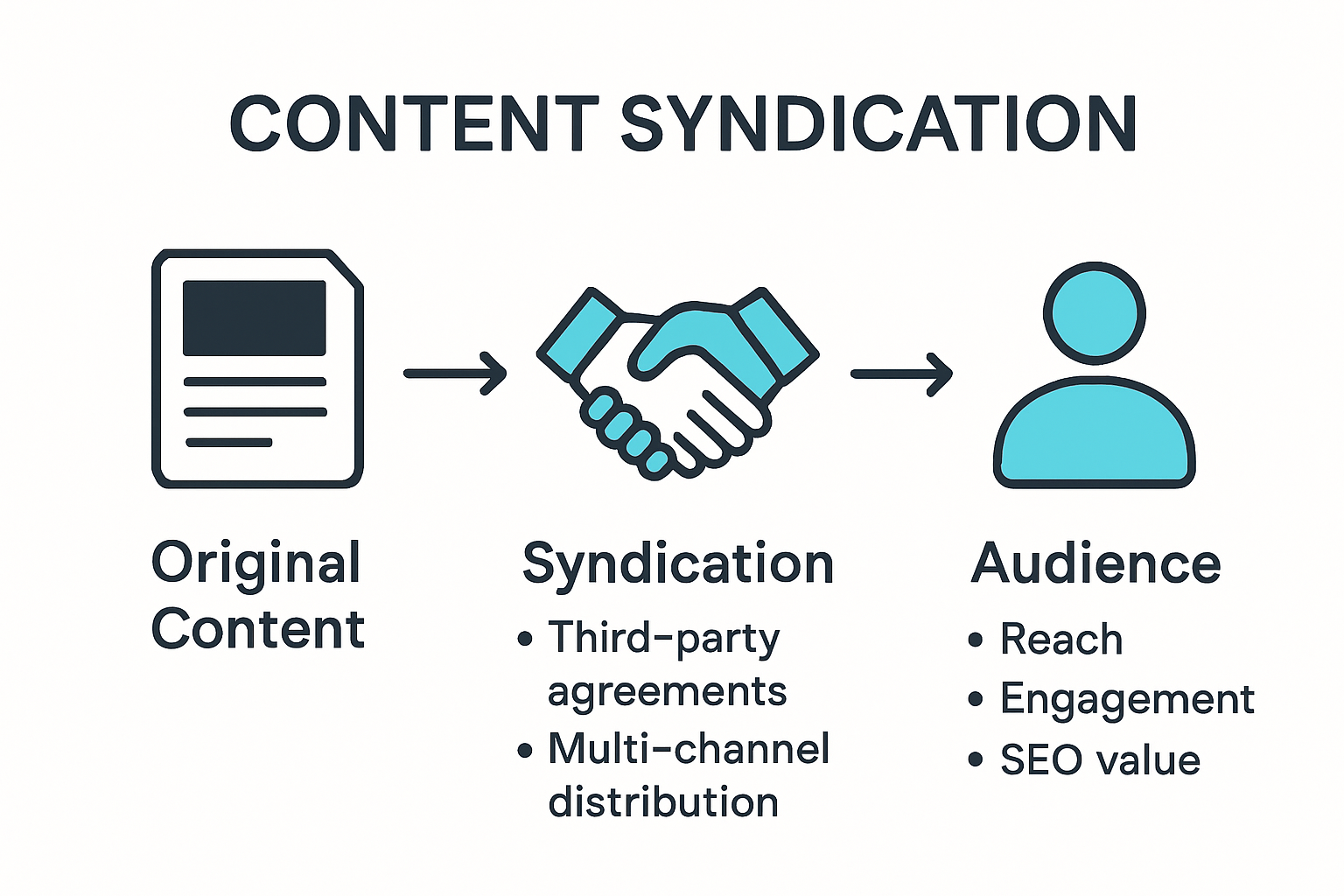CATEGORIES
TAGS
What is Content Syndication? Understanding Its Impact

Content syndication sounds simple on the surface. It lets one article spark across dozens of websites and reach readers you never imagined. But wait. Nearly 60 percent of marketers credit content syndication with helping their brands tap entirely new audiences. The twist is that it is not just about spreading articles farther. It is about using the right strategy and structure so each piece works harder for your business, not just appearing everywhere.
Table of Contents
Quick Summary
TakeawayExplanationContent syndication expands reach.It allows creators to distribute their content across multiple platforms to gain more visibility and engagement.Strategic partnerships are essential.Choosing the right syndication partners aligns your content with audiences that share your brand values.Proper attribution is crucial.Always ensure content credits the original creator to uphold trust and credibility in redistribution efforts.Monitoring performance impacts success.Implement tools to track engagement and traffic from syndication to evaluate effectiveness and optimize strategies.SEO benefits arise from syndication.Properly executed syndication can improve search rankings and online presence through increased visibility.
Defining Content Syndication: What It Is
Content syndication represents a strategic digital publishing approach where original content is republished and distributed across multiple websites, platforms, and channels to expand reach and engagement. At its core, this practice allows content creators to maximize their work’s visibility by sharing it beyond its original publication point.
Understanding the Fundamental Mechanics
Content syndication operates through a straightforward mechanism where content owners grant permission for their material to be republished by third-party platforms. This process involves several key elements:
Original Content Creation: Developing high-quality, valuable content that other platforms would find interesting
Syndication Agreement: Establishing clear terms about how and where content can be republished
Distribution Channels: Selecting appropriate platforms for content redistribution
The primary goal of content syndication is to broaden content exposure, drive traffic back to the original source, and establish thought leadership within a specific industry or niche. By strategically sharing content across different digital spaces, creators can tap into new audiences and potentially improve their search engine optimization (SEO) performance.

Benefits and Strategic Implications
Content syndication offers multiple advantages for digital publishers and content creators. According to Content Marketing Institute, this approach enables businesses to:
Below is a summary table highlighting the key benefits of content syndication as described in the article. This table helps to quickly compare the distinct strategic advantages for businesses and brands.
BenefitDescriptionIncreased Brand VisibilityBoosts awareness by publishing content on multiple sitesBroader Audience ReachAccesses new reader segments across different platformsAdditional Website TrafficDrives more visitors back to the original sourceEnhanced Brand CredibilityBuilds trust through exposure on respected third-party sitesCost-Effective Content DistributionLeverages existing content to reduce production expensesImproved SEO PerformanceEnhances rankings and online presence with greater visibility
Increase brand visibility and awareness
Reach broader audience segments
Generate additional website traffic
Build credibility through widespread content distribution
While content syndication can be highly effective, it requires careful implementation. Creators must ensure proper attribution, maintain content quality, and select syndication partners that align with their brand’s values and target audience. By understanding these nuanced dynamics, content creators can leverage syndication as a powerful marketing and distribution strategy.
The Importance of Content Syndication in Marketing
Content syndication has emerged as a powerful strategic tool in modern digital marketing, transforming how brands communicate and expand their reach. By redistributing content across multiple platforms, businesses can amplify their messaging, attract new audiences, and establish thought leadership within their industry.
Strategic Marketing Amplification
Marketing professionals recognize content syndication as a critical mechanism for extending brand visibility beyond traditional marketing channels. This approach allows companies to leverage existing content assets more effectively, creating multiple touchpoints for potential customers without generating entirely new material.
Key strategic advantages include:
Cost-Effective Content Distribution: Repurposing existing content reduces production expenses
Expanded Audience Reach: Access to new reader segments across different platforms
Enhanced Brand Credibility: Increased exposure through respected third-party channels
According to Harvard Business Review, syndication represents an evolutionary approach to digital content strategy, enabling businesses to maximize their intellectual property’s potential.
Performance and SEO Implications
Content syndication directly impacts marketing performance metrics by driving increased web traffic, improving search engine rankings, and generating potential leads. When executed strategically, syndicated content can significantly boost a brand’s digital footprint. Learn more about our content strategy insights.

Successful content syndication requires careful partner selection, maintaining content quality, and ensuring proper attribution. Marketers must prioritize platforms that align with their target audience and brand values, transforming content distribution from a passive activity into an active marketing strategy.
By understanding and implementing content syndication effectively, businesses can create a robust, versatile approach to digital marketing that extends far beyond traditional advertising methods.
How Content Syndication Works for Brands and Audiences
Content syndication functions as a sophisticated digital ecosystem where content creators, publishers, and audiences interact through strategic content distribution networks. This collaborative process enables seamless content sharing while maintaining clear attribution and value exchange for all participants.
The Syndication Workflow
The content syndication mechanism operates through a structured sequence of interactions between key stakeholders:
To clarify the overall workflow of content syndication, here is a table summarizing each step and its purpose. This makes it easier to visualize how the process works from start to finish.
Syndication StepPurpose/DescriptionContent OriginationCreators develop high-quality, relevant contentLicensing & PermissionsAgreements define rights and conditions for reusePlatform DistributionContent gets republished with attribution on partner sitesAudience EngagementAudiences interact with the content across channelsPerformance TrackingMetrics and analytics measure engagement/impact
Content Origination: Original creators develop high-quality, relevant content
Licensing and Permissions: Formal agreements define content usage rights
Platform Distribution: Third-party platforms republish content with proper attribution
Audience Engagement: Readers consume content across multiple digital touchpoints
According to EDUCAUSE, this process transforms traditional content consumption by enabling dynamic information sharing across digital platforms.
Technical and Strategic Considerations
Successful content syndication requires sophisticated technical infrastructure and strategic planning. Publishers must implement robust mechanisms to track content performance, manage licensing agreements, and ensure proper link attribution. Learn more about our content distribution strategies.
Key technical components include:
RSS feeds for automated content distribution
Canonical link tags to prevent SEO duplicate content penalties
Tracking pixels for audience measurement
Content management systems supporting syndication workflows
By understanding these intricate dynamics, brands can transform content syndication from a simple republishing strategy into a powerful audience engagement and brand visibility mechanism. The most effective syndication approaches balance technical precision with strategic content alignment, creating value for creators, publishers, and audiences simultaneously.
Key Concepts and Strategies in Content Syndication
Content syndication requires a nuanced understanding of digital publishing strategies that go beyond simple content redistribution. Successful implementation demands strategic planning, comprehensive legal frameworks, and sophisticated technical infrastructure to maximize content value and audience engagement.
Strategic Partnership Framework
Effective content syndication relies on establishing robust partnership models that create mutual benefits for content creators and distribution platforms. These partnerships involve carefully negotiated terms that protect intellectual property while expanding content reach.
Key strategic considerations include:
Selective Partnering: Choosing platforms aligned with brand values and audience demographics
Licensing Complexity: Developing clear agreements about content usage rights
Performance Tracking: Implementing mechanisms to measure content impact across different platforms
According to University of Texas at Austin research, successful syndication models prioritize maintaining content integrity while maximizing distribution potential.
Technical and Legal Infrastructure
Content syndication requires sophisticated technical mechanisms to ensure seamless distribution and legal protection. Explore our content distribution guidelines for deeper insights into developing robust syndication strategies.
Critical technical elements include:
Canonical link implementations
Automated content tracking systems
Digital rights management protocols
Cross-platform performance analytics
By understanding these intricate dynamics, organizations can transform content syndication from a passive distribution strategy into an active audience engagement mechanism. The most effective approaches balance technological precision with strategic content alignment, creating sustainable value for creators, publishers, and audiences.
Take Your Content Syndication to the Next Level With Prodcast
Are you struggling to amplify your content reach or turn increased visibility into real, measurable engagement? The article highlighted a major challenge in the world of content syndication. It is not just about republishing content. It is about making sure each piece of content actually connects with new audiences, drives traffic, and translates into clear results. Many marketers and creators are searching for new ways to move beyond passive publishing. They want actionable insights, true audience connection, and direct paths to monetization.

Imagine combining the power of syndication with AI-driven discovery and commerce. At Prodcast your content gets more than just exposure. Our platform uses advanced AI to scan and categorize podcast moments, indexing spoken content to surface featured products and significant discussions. This makes every mention and story instantly findable and shoppable. Whether you want to promote your own products or reach an engaged buyer audience, learn more about our content distribution strategies and empower yourself to become a vendor in a fast-growing podcast marketplace. Don’t wait for passive results. Join our dynamic platform and transform your syndication strategy today. Start with Prodcast and unlock the future of content-driven commerce.
Frequently Asked Questions
What is content syndication?
Content syndication is a digital publishing strategy where original content is republished across multiple platforms and websites to increase visibility and engagement.
How does content syndication benefit businesses?
Content syndication allows businesses to enhance brand visibility, reach broader audience segments, generate more traffic, and build credibility through widespread distribution of their content.
What are the key elements involved in content syndication?
The key elements include original content creation, syndication agreements that define usage rights, and selecting suitable distribution channels for the content.
How does content syndication affect SEO performance?
When executed strategically, content syndication can drive increased web traffic, improve search engine rankings, and help establish thought leadership, contributing positively to overall SEO performance.